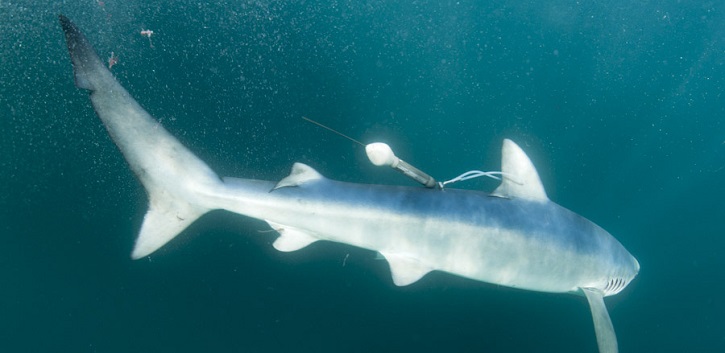Sharks at increasing risk of becoming fishing bycatch 25 Jul 2019

Large sharks inhabiting the open ocean account for over half of all identified shark catch globally in target fisheries or as bycatch. Regional declines in abundance of some populations such as shortfin mako shark – the fastest shark in the sea – have led to widespread calls for catch limits in the High Seas (areas beyond national jurisdiction), where there is currently little or no management for sharks.
But precisely where in the vast expanse of the ocean’s sharks aggregate and how much fishing takes place in those chosen habitats remains poorly known globally, even though it will be crucial to selecting sites to conserve sharks.
Now, an international team of over 150 scientists from 26 countries have tackled this knowledge gap by collating movement data from nearly 2,000 sharks tracked with satellite transmitter tags.
Researchers mapped shark positions and revealed ‘hotspots’ of space use in unprecedented detail. They found multi-species pelagic shark hotspots were mostly located in frontal zones, boundaries in the sea between different water masses that are highly productive and food-rich.
They then calculated how much the hotspots were overlapped by global fleets of large, longline fishing vessels – the type of fishing gear that catches most pelagic sharks – with each vessel capable of deploying 100 km long lines bearing 1200 baited hooks daily.
Strikingly, they found 24% of the mean monthly space used by sharks globally falls under the footprint of pelagic longline fisheries. For commercially exploited sharks such as North Atlantic blue and shortfin makos sharks overlap was much higher, with on average 76% and 62% of their space use, respectively, overlapping with longlines each month. Even internationally protected species such as great white and porbeagle sharks had overlap values exceeding 50%.
UCC researchers Dr Tom Doyle, a lecturer in Zoology at the School of Biological, Earth and Environmental Sciences, ERI, UCC, and Luke Harman, a funded investigator in MaREI, an SFI research centre, contributed track data from blue sharks tagged in Irish waters. When combined with other blue shark tracks in the North-East Atlantic, the tracks show that blue shark space use has one of the highest monthly overlaps with pelagic longline fisheries (76%).
Dr Doyle said: “We knew that blue sharks are one of the most frequently captured sharks but to find such a high overlap between their space use and fishing activity is worrying. So despite being one of the most abundant and widespread large predators in the North East Atlantic, blue sharks have very few places to hide”.
“Blue sharks occur every year in Irish waters, arriving as early as June and disappearing from September. Research has shown that the majority of blue sharks that visit Irish waters are subadult females. All our tagged sharks swam directly through heavily fished waters and one was captured in oceanic waters west of the Iberian peninsula," Harman said.
The blue sharks tagged by Dr Doyle and Harman were captured on camera by wildlife photographer Nigel Motyer. The blue shark contribution from Ireland was supported by UCC’s Strategic Research Fund.
“Our results show major high seas fishing activities are currently centred on ecologically important shark hotspots worldwide,” said Professor David Sims, who led the study as part of the Global Shark Movement Project based at the Marine Biological Association Laboratory in Plymouth, UK.
Equally alarming was that shark hotspots showing high overlap with longline fishing were often also subjected to high fishing effort, a potential ‘double whammy’ for sharks that will result in higher catch rates and potentially accelerate declines in abundance.
Given the high fishing effort in hotspots of many species for significant portions of the year, and the very few tracked hotspots free from exploitation, the study reveals exposure risk of sharks to fisheries in the high seas is spatially extensive – stretching across entire ocean-scale population ranges for some species.
The team’s findings indicate large sharks – some of which are already endangered globally – face a future with limited spatial refuge from industrial longline fishing effort.
The researchers propose that the detailed maps of shark hotspots and exposure to longline fishing effort they have produced can provide a ‘blueprint’ for use in deciding where to place large-scale marine protected areas (MPAs) aimed at conserving sharks, in addition to the need for strict quotas to reduce catches elsewhere.